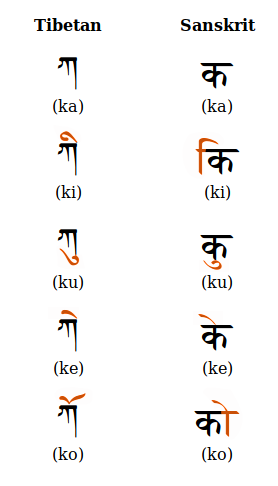Tibetan and Sanskrit: Language Similarities and Differences

The Himalayas separate India from the Tibetan Plateau. Sanskrit is an ancient language that developed south of the Himalayas; Tibetan developed to the north.
From the Potala Palace in Lhasa (the capital of the Tibet Autonomous Region) to the Taj Mahal, there’s roughly the same distance (in a straight line) as between Chicago and New York City.
The big difference is that between the first two, there are jagged mountain peaks like Mount Everest.
While Chicago and NYC have the same language (the main difference is the accent), the difference between Tibetan and Sanskrit is large.
Tibetan is in the Sino-Tibetan family of languages (which also includes Mandarin Chinese and Burmese). Sanskrit, in contrast, is an Indo-Aryan language. That’s a branch of the larger Indo-European language family (which includes English).
Although Tibetan and Sanskrit are not linguistically related languages, their writing systems do have a common origin.
Vocabulary comparison
The basic vocabulary words differ considerably in Tibetan compared to Sanskrit, as can be seen in the table below.
| Tibetan | Sanskrit | English |
|---|---|---|
| ཞི་བདེ (zhi bde) | शान्ति (shanti) | peace |
| བརྩེ་བ (brtse ba) | प्रेमन् (preman) | love |
| པ་ཕ (pa pha) | पितृ (pitṛ) | father |
| གངས (gangs) | हिम (hima) | snow |
| ཉི་མ (nyi ma) | सूर्य (sūrya) | sun |
| ཟླ་བ (zla ba) | चन्द्र (candra) | moon |
| རི (ri) | गिरि (giri) | mountain |
| གནམ (gnam) | आकाश (ākāsha) | sky |
| ཆུ (chu) | पानीय (pānīya) | water |
| མེ (me) | अग्नि (agni) | fire |
| སེམས (sems) | चित्त (citta) | mind |
| བདེ་བ (bde ba) | सुख (sukha) | happiness |
| ཤིང་ཏོག (shing tog) | फल (phala) | fruit |
| བསམ་གཏན (bsam gtan) | ध्यान (dhyāna) | meditation |
| ལས (las) | कर्मन् (karman) | karma |
| སྔགས (sngags) | मन्त्र (mantra) | mantra |
There are a few vocabulary words that Tibetan borrowed from Sanskrit. For example, the term པད་མ (pad ma) in Tibetan means “lotus”, and it comes from the Sanskrit word पद्म (padma).
Related resources include this list of the thousand most common Sanskrit words and our article on Sanskrit words used in yoga.
Vowel marks
Consonant symbols in Tibetan and Sanskrit have an inherent vowel, which is 'a' by default for both languages. Additional marks are added to the consonant to change the inherent vowel.
The vowel marks used in Tibetan and those used in Sanskrit have somewhat similar shapes as can be seen in the examples below.

Sanskrit has additional vowel marks that are absent in Tibetan. This is because written Sanskrit makes a distinction between long and short vowels, whereas written Tibetan does not.
Additional differences
In Sanskrit, each noun has one of three possible grammatical genders (masculine, feminine, or neuter) whereas Tibetan nouns don’t have grammatical gender.
Several modern dialects of Tibetan, including Lhasa Tibetan, are tonal languages. This means that the pitch or tone in which a syllable is pronounced can change the meaning of a word. In contrast, Sanskrit is not a tonal language.
Sanskrit and Tibetan Literature
Many of the most studied Tibetan language texts are related to Tibetan Buddhism. Here are some examples of such texts:
- The Bardo Thodol, commonly known in the West as “The Tibetan Book of the Dead”, is one of the best-known Tibetan texts.
- The Hundred Thousand Songs of Milarepa: a collection of songs and poems attributed to the eleventh-century Tibetan yogi Milarepa, one of Tibet's best-known spiritual masters.
- Kangyur and Tengyur: These are collections of Tibetan Buddhist scriptures. The Kangyur consists of translated discourses from the Buddha, while the Tengyur contains commentaries on the teachings of the Buddha.
- The Jewel Ornament of Liberation: this Tibetan text was written by Gampopa, a disciple of Milarepa. It is a key text in the Kagyu lineage of Tibetan Buddhism.
Some of the most studied Sanskrit texts include:
- The Bhagavad Gita: This is one of the most famous Sanskrit texts, and it is a part of the larger Indian epic Mahabharata. It is written in the form of a dialogue between Prince Arjuna and Krishna, who serves as his charioteer and spiritual guide. Students of Sanskrit will benefit from bilingual editions of the text, such as Winthrop Sargeant's translation, which presents the original Sanskrit and the English translation next to each other.
- The Vedas: These ancient texts form the foundation of Hinduism. One of them, the Rigveda, is the earliest known Sanskrit-language text. Because the use of Sanskrit has spanned thousands of years, there are several forms of the language — the oldest is called Vedic Sanskrit.
- The Yoga Sutras of Patanjali: A guide to yoga philosophy and practices.
- The Ramayana and the Mahabharata: The two major ancient Sanskrit epics.
- The Upanishads: treatises exploring the nature of reality and self-realization.